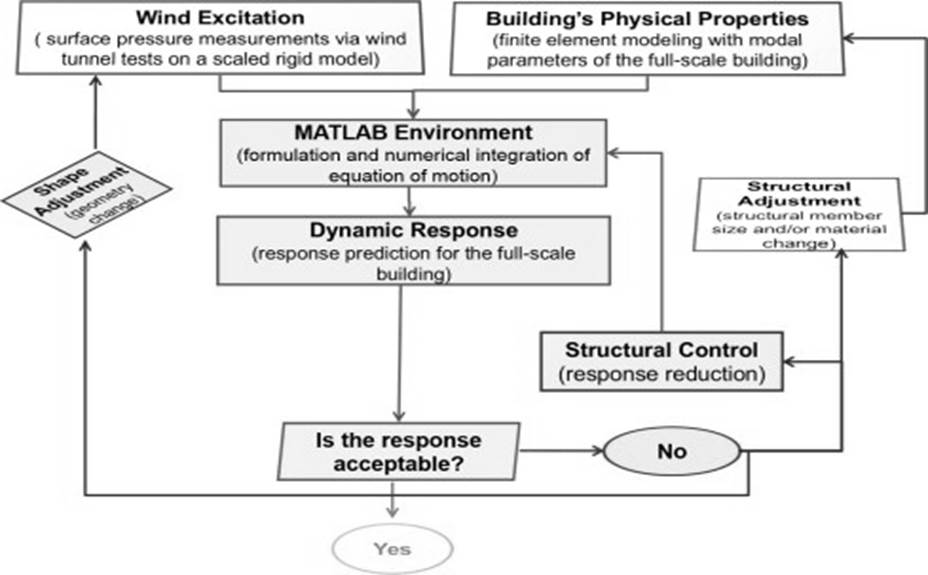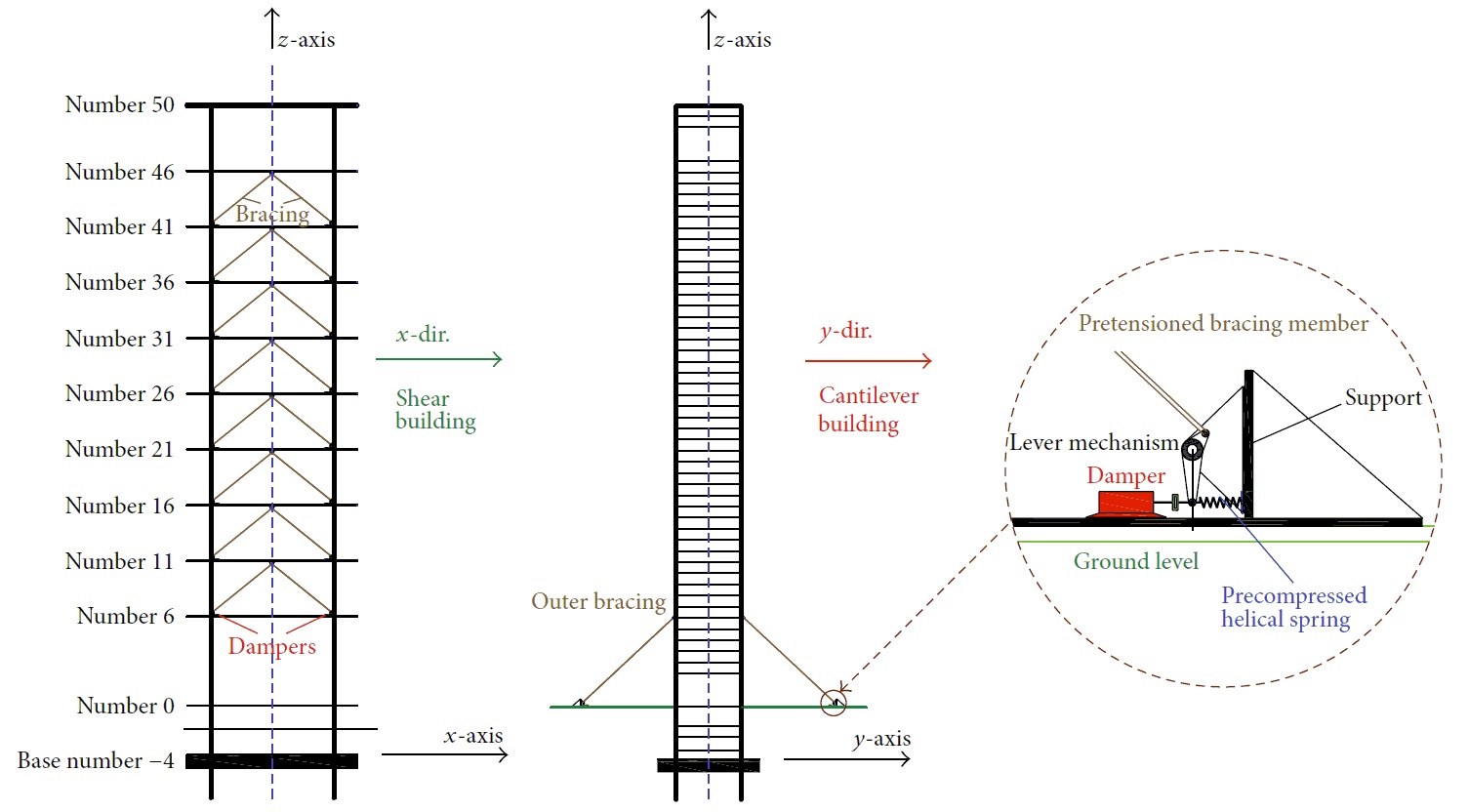🌬️ Wind-Induced Dynamics and Loads: Enhancing Infrastructure Performance and Resilience
The escalating demand for reliable and efficient modern infrastructure, particularly structures built with advanced materials, necessitates rigorous evaluation against dynamic environmental forces. The WISE Research Lab is dedicated to comprehending the behavior of critical infrastructure systems—such as high-rise buildings and wind turbines—under multiple hazards (including wind, waves, earthquakes, and operational imbalances) during both idle and active conditions.
Comprehensive Structural Dynamics Modeling
Our research employs a comprehensive modeling approach to fully account for the complex interactions within a structure and between the structure and its dynamic environment. A key contribution is the development of an innovative, energy-based methodology to design and optimize advanced control systems, ensuring effective vibration mitigation across various hazard scenarios.
Focus Areas
- Wind Turbine Resilience: Evaluating the performance of these critical energy systems in harsh offshore environments to prevent failure from excessive vibrations and operational imbalances.
- High-Rise Building Safety: Addressing challenges where wind-induced accelerations can compromise occupant comfort and serviceability, while extreme inter-story drifts threaten structural safety.
Mitigation Strategies for Multi-Hazard Loading
To address the heightened risks of failure and excessive vibrations, our research implements advanced damping technologies as a core mitigation strategy.
Fluid Viscous Dampers (FVDs)
- Multi-Hazard Efficacy: We utilize Fluid Viscous Dampers to effectively mitigate the effects of both wind and earthquake loads.
- Optimal Placement: Through rigorous analysis, we determine the optimal number and strategic placement of dampers based on modal drifts and targeted response values.
- Lever Mechanism: Our findings demonstrate that positioning viscous dampers with a lever mechanism allows for the use of smaller damping devices while achieving higher response reductions and enhancing the system's robustness against uncertainties and potential damper failure.
Performance Evaluation
Our evaluation encompasses various system-level performance criteria to facilitate informed decision-making:
- Displacement and Absolute Acceleration
- Inter-story Drift Ratio (critical for nonstructural damage)
- Shear Force and Base Bending Moment



Relevant Publications
- Aly, A.M., Chapain, S. (2023), "Seismic response reduction using a tuned pendulum pounding mass damper: Experimental verification of superior performance," Soil Dynamics and Earthquake Engineering, 173, October 2023, 108044 https://doi.org/10.1016/j.soildyn.2023.108044.
- Longarini, N, Zucca, M, Crespi, P, Valente, M, Aly, A.M. (2024), "Tuned Mass Dampers for Improving the Sustainability and Resilience of Seven Reinforced Concrete Chimneys Under Environmental Loads," Environment, Development and Sustainability. https://doi.org/10.1007/s10668-024-04603-8
- Chapain, S., Aly, A.M. (2023), "Vibration Attenuation in a High-Rise Hybrid-Timber Building: A Comparative Study," Applied Sciences, 2023, 13(4), 2230. https://doi.org/10.3390/app13042230
- Chapain, S., Aly, A.M. (2023), "Vibration Attenuation in a High-Rise Hybrid-Timber Building: A Comparative Study," Applied Sciences, 2023, 13(4), 2230. https://doi.org/10.3390/app13042230
- Aly, A.M., Hoffmann, M. (2022), "A Case Study of Protecting Bridges Against Overheight Vehicles," Steel and Composite Structures, 43(2), 165-183. https://doi.org/10.12989/scs.2022.43.2.165
- Chapain, S., Aly, A.M., (2021), "Vibration attenuation in wind turbines: A proposed robust pendulum pounding TMD," Engineering Structures 233, 111891. https://doi.org/10.1016/j.engstruct.2021.111891
- Zucca, M., Longarini, N., Simoncelli, M., Aly, A.M. (2021), "Tuned Mass Damper Design for Slender Masonry Structures: A Framework for Linear and Nonlinear Analysis," Applied Sciences 11 (8), 3425. https://doi.org/10.3390/app11083425
- Aly, A.M., Rezaee, M. (2021), "Accelerated Controller Tuning for Wind Turbines Under Multiple Hazards," Journal of Energy and Power Technology 3(1), 1-31. DOI: 10.21926/jept.2101011
- Xie, F., Aly, A.M. (2020), “Structural Control and Vibration Issues in Wind Turbines: A Review,” Engineering Structures, 210(May), 110087. DOI: 10.1016/j.engstruct.2019.110087
- Chapain, S., Aly, A.M. (2019), "Vibration Attenuation in High-Rise Buildings to Achieve System-Level Performance under Multiple Hazards," Engineering Structures," Engineering Structures, Volume 197, 15 October 2019, 109352. DOI: 10.1016/j.engstruct.2019.109352
- Rezaee, M., Aly, A.M. (2018), "Vibration Control in Wind Turbines to Achieve Desired System-Level Performance under Single and Multiple Hazard Loadings," Structural Control and Health Monitoring, DOI:10.1002/stc.2261.
- Longarini, N., Cabras, L., Zucca, M., Chapain, S., Aly, A.M. (2017), "Structural Improvements for Tall Buildings under Wind Loads: Comparative Study," Shock and Vibration, 2017, Article ID 2031248, 19 pages. doi:10.1155/2017/2031248
- Abdelkader, A.M., Aly, A.M., Rezaee, M., et al. (2017), "On the Evaluation of Wind Loads for Wind Turbines’ Foundation Design: Experimental and Numerical Investigations," The Structural Design of Tall and Special Buildings, 26(9), 14 pages. doi: 10.1002/tal.1362.
- Rosa, L., Tomasini, G., Zasso, A. and Aly, A.M. "Wind-induced dynamics and loads in a prismatic slender building: modal approach based on unsteady pressure measures," Journal of Wind Engineering and Industrial Aerodynamics, 107-108, 118-130, 2012.
- Aly, A.M. "Pressure Integration Technique for Predicting Wind-Induced Response in High-Rise Buildings," Alexandria Engineering Journal, Elsevier, Volume 52, Issue 4, December 2013, Pages 717-731. DOI: https://doi.org/10.1016/j.aej.2013.08.006